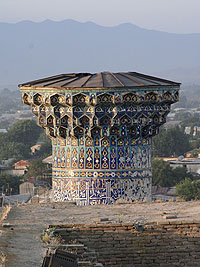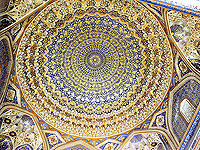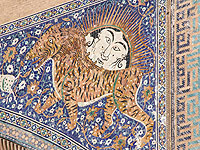 |
|
Uzbekistan - Architecture |
||||
|
Uzbekistan is a country of ancient high culture with its exceptional architectural patterns. Famous historians of the East in their writings on the ancient cities such as Bukhara , Samarkand and Khiva and other places mention palaces of the rulers, places of residence of aristocracy, market places, madrasah, mausoleums, and describe them as very beautiful with evergreen gardens. The Kyrk-Kyz ('Forty Girls') mansion in Termez dating back the 9th- 10th centuries is a fine example of an original country manor. The Samanids Mausoleum in Bukhara still stands as a fine architectural building from the marvelous period of early Middle Ages. In the llth-12th centuries, Samarkand became one of the major cities in the region. There was intensive construction of attractive houses, civil and religious buildings. The growth of cities, increase of the urban population, and expansion of internal and international trade routes caused construction of many caravansaries (an inn for caravans) near the cities. The Raboti-Malik, the caravansary near Navoi, still stands as a fine example. It was a large structure where dozens of caravans could be accommodated at the same time. Among the city structures, a number of urban places, such as mosques and praying houses were designed with special attention. The Khakim at-Termizy Mosque was viewed as simple, yet a highly valuable and beautiful architectural building with simplicity to be proud of. For many buildings a geometric pattern is common which is characterized by a large variety of rich plates with fine art applications over mud bricks. Beginning the 13th century, Central Asia saw invasion by Genghis- Khan and his descendants for nearly a hundred years. And just in the first half of the 14th century, the reconstruction of the destroyed towns and villages has begun. In its turn, it once again promoted the rise of the architectural activity in the region. Architecture of Temur's period stood as a fine example of a modern city in the 13th century. Strong castles were symbols of strong government, authority and victory of the Islamic civilization, marketplaces - symbols of the role of trade, and living quarters - the essence of the complex urban life. The rise of a city-building culture lasted for almost another hundred years when Ulughbek - grandson of Amir Temur - ruled the region. Among the most significant buildings created at that time were palaces, such as Oksaroy in Shakhrisabz, the Bibi-Khonim Mosque, and the Guri Amir Mausoleum, large part of the complex of Shokhi Zinda, the Ulughbek Madrasah in Samarkand. Architects of the time paid a great deal of attention to the art of gardening and horticulture with greenery going in harmony with water and architecture. In the 1648th century cultures the great architectural activity was concentrated in large cities such as Bukhara, Samarkand, Karmana, and Tashkent. There was further development for residences, markets and caravansaries. The architectural buildings of Central Asia in the 16th and 17th centuries are very famous around the world. A few of them are Registan in Samarkand, Minarai Kalon, Labi Khovuz, and the Ulughbek and Abdulaziz Khan madrasah in Bukhara , and other. Khiva became a fine example of Central Asian open-museum city in the middle of the 18th century when there were constructed large ensembles and buildings. The Tashkhauli palace (1830-38), the Muhammad of Olimkhon madrasah (1851-55), and Kakaminar minaret (1855) are some examples of fine architectural buildings of the city. Residential architecture of an ordinary Uzbek citizen at the end of the 19th and the beginning of 20th centuries is very interesting. It consists of experience from the previous centuries and reflects local conditions and peculiarities of the region. For instance, an inhabited house in Bukhara has a closed character and is isolated from the street noise and dust. Its isolated rooms were built according to the weather changes and create a unique microclimate in both the heat and cold. An increased terrace opened to the wind promotes the creation of a favorable microclimate in houses in Khiva. In Ferghana, for example, houses had sliding walls and shutters, and were decorated with niches, ganch (wooden architecture), and other characteristic conditions. The interior of national Uzbek houses was very simple, yet very rational and original. The national foremen carefully transferred the knowledge and experience from generation to generation. |


